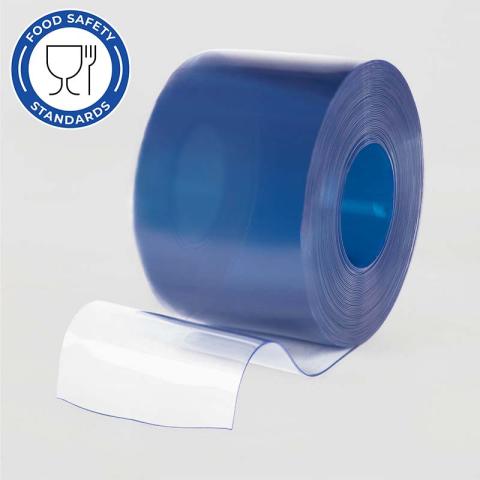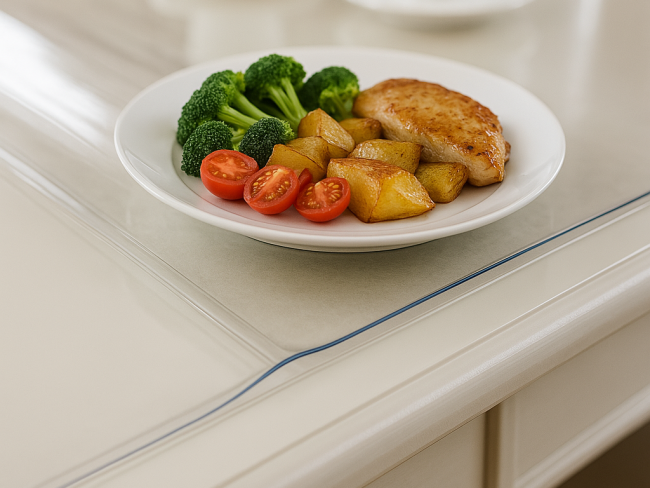Explore what makes PVC strip curtains truly food safe — from FDA, USDA, and CFIA certifications to the critical role they play in hygiene, compliance, and contamination control.

Food safety isn’t just about what’s on the plate — it starts with the environment where food is handled, stored, and prepared. In facilities across North America, from meat processing plants to refrigerated warehouses, even the smallest detail matters when it comes to hygiene and compliance.
That includes the materials used to separate spaces. PVC strip curtains, when designed for food contact applications, do more than control temperature or block airflow — they help prevent cross-contamination, manage sanitation zones, and support regulatory compliance.
So what exactly makes a PVC strip “food safe”? In this article, we’ll break down the key regulations in the U.S. and Canada, explain how food-grade PVC is engineered, and highlight where these materials are most effective in your facility.
What does “food safe” mean for PVC?
In food-related environments, the term “food safe” isn’t just a marketing label — it reflects a material’s compliance with strict health and safety standards. When applied to PVC strip curtains, food safe means the material can be safely used in areas where food is stored, handled, or prepared, without posing a risk of contamination.
To meet this standard, PVC must be:
- Non-toxic: It cannot release harmful chemicals that might affect food quality or safety.
- Low-migration: It must resist transferring substances — such as plasticizers or additives — onto surfaces it comes into contact with.
- Formulated for food environments: Ingredients used in the PVC formulation must comply with relevant North American regulations, including those from the U.S. Food and Drug Administration (FDA), the United States Department of Agriculture (USDA), and the Canadian Food Inspection Agency (CFIA).
Unlike standard PVC used in industrial applications, food-safe PVC is specifically engineered to ensure that it does not introduce contaminants — even in high-traffic environments like cold storage rooms, meat processing areas, or packaging zones. This ensures not only regulatory compliance but also peace of mind for food safety professionals and operations managers alike.
Certifications that matter in North America
In food environments regulated by U.S. and Canadian authorities, compliance is a prerequisite for operation. When selecting PVC strip curtains for these settings, it’s critical to verify that the materials meet specific regulatory standards for incidental food contact. Extruflex PVC is engineered and certified to satisfy the most stringent requirements across North America.
Here’s how Extruflex delivers:
- FDA-compliant (United States): Extruflex PVC is formulated in accordance with U.S. Food and Drug Administration (FDA) standards for materials used in proximity to food. This ensures the product is non-toxic and suitable for use in environments such as food prep zones, packaging lines, and storage areas.
- USDA-compliant: Approved for use in USDA-inspected facilities, Extruflex PVC is suitable for meat, poultry, and egg processing environments where hygiene, traceability, and durability are paramount.
- CFIA-approved (Canada): In Canadian food facilities, Extruflex PVC meets the requirements of the Canadian Food Inspection Agency (CFIA), authorizing its use in inspected plants and storage areas regulated under Canadian law.
To further support compliance and quality assurance, Extruflex provides complete documentation, including:
- Certificates of compliance that confirm regulatory adherence
- Batch traceability to verify manufacturing origin and control
- Formulation transparency to support audits and inspections
For food safety professionals, procurement managers, and facility operators, these certifications and records are essential tools for maintaining operational integrity — and passing inspections with confidence.
Key features of Extruflex PVC strips
In high-compliance food environments, material performance matters just as much as certification. PVC strip curtains must deliver more than regulatory approval — they need to perform reliably in fast-paced, hygiene-critical spaces. Extruflex PVC strips are designed with key features that support both food safety and operational efficiency:
- Crystal-clear visibility: Extruflex PVC offers exceptional optical clarity, enabling staff to safely navigate high-traffic areas and monitor activities across work zones. This visibility improves safety and coordination in environments like packaging lines, loading docks, and walk-in coolers.
- Smooth, non-porous surface: The strips are easy to clean and disinfect, thanks to their smooth and non-porous structure. This prevents the buildup of bacteria, dust, or food residue — supporting strict sanitation protocols and simplifying cleaning routines.
- Durability in demanding conditions: Designed to withstand constant use, Extruflex PVC strips remain flexible and impact-resistant even in low-temperature environments. This makes them ideal for cold storage areas, refrigerated warehouses, and freezer access points.
- Safe, transparent formulation: Extruflex food-grade PVC is manufactured without phthalates or other restricted substances. Every batch is formulated for use in regulated food industry zones, offering peace of mind for compliance officers and procurement teams.
Whether used as a barrier to reduce airborne contaminants or to separate hygiene zones, these features ensure that Extruflex PVC strips are not only compliant — they’re also built for real-world food facility demands.

Where PVC strips are used in food facilities
In food facilities PVC strip curtains play a critical role in maintaining hygiene and controlling temperature across a wide range of operational zones. Their versatility makes them an essential fixture in regulated environments, from production floors to distribution points.
Common applications include:
- Food processing lines and prep zones: PVC strips help separate raw and ready-to-eat areas, supporting zoning protocols and minimizing the risk of contamination during handling and preparation.
- Cold storage and chilled distribution areas: In walk-in freezers, blast chillers, and refrigerated loading zones, PVC strips maintain consistent temperatures and reduce thermal exchange during frequent access.
- Packaging and labeling areas: Strip curtains provide a physical barrier that helps isolate clean packing zones, ensuring that finished products are protected from dust, insects, and airborne contaminants.
- Washdown and clean zones: Made with smooth, non-porous surfaces, Extruflex PVC strips are ideal for areas requiring regular sanitation. They withstand moisture, cleaning agents, and high-frequency cleaning cycles.
- Loading docks and food transport staging areas: Strip curtains act as flexible barriers that block external contaminants while allowing for seamless movement of goods and personnel.
- Secondary containment behind doors: PVC strips can be installed behind powered or manual doors to provide an additional layer of insulation, zone control, or biosecurity — without obstructing workflow.
By integrating PVC strips strategically throughout the facility, food manufacturers and distributors can uphold sanitation standards while improving operational efficiency.
Choosing the right PVC means choosing safety
Extruflex food-grade PVC is specifically engineered for use in the most demanding food industry settings. Compliant with FDA & USDA regulations and with approval from the CFIA, and supported with full traceability and compliance documentation, our products deliver the performance and peace of mind your facility needs.
Preparing for a food safety audit or choosing materials for a new installation?
Get in touch with the Extruflex team for documentation, samples, or technical guidance tailored to your facility.
